For India to become the next manufacturing powerhouse, it must first learn from China – with or without the coronavirus
- The crippling disruption to Chinese supply lines has inspired talk of India capitalising on Covid-19 to boost its ‘Make in India’ push. But the challenge of setting up a suitable supply network, with the skilled workforce to operate it, is daunting even before India went into a lockdown of its own

China’s economy has suffered an unexpected double whammy. The trade war unilaterally launched by US President Donald Trump first sent businesses on a frantic search for alternative supply chains, and now the Covid-19 pandemic has further disrupted global supply chains.
Can India seize the opportunity to give China a run for its money in global manufacturing? The answer hides in a paradox: India needs China before it can replace China.
When Prime Minister Narendra Modi launched the “Make in India” campaign in 2014, it was a policy melange that hardly differentiated between the industrial sectors in which India had comparative advantages and those where it had none. As a result, under “Make in India”, the share of manufacturing in terms of India’s gross domestic product even fell – from 15 per cent in 2014 to 14 per cent in 2019.

